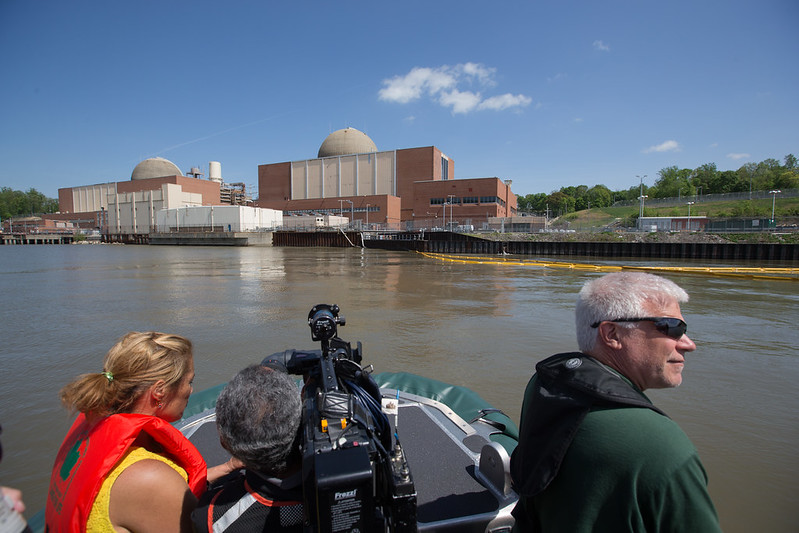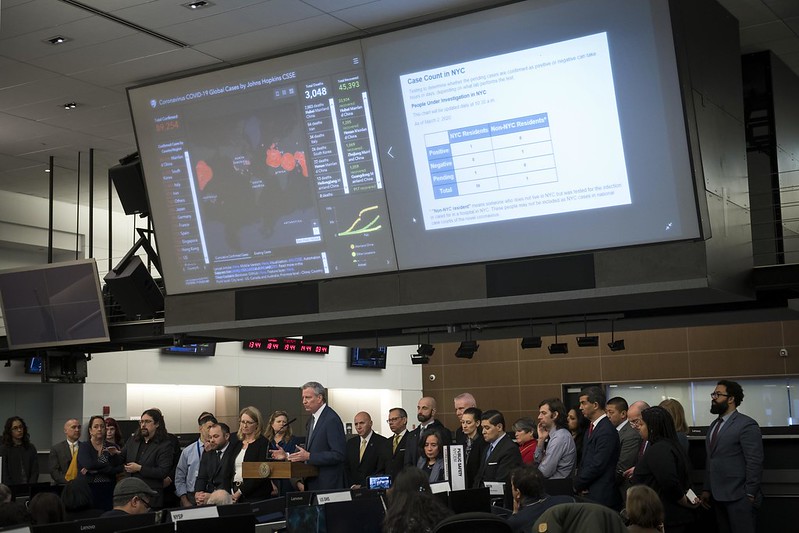New York Has Already Moved Beyond Indian Point Nuclear Power; Here’s Where We’re Headed

(photo: Kevin P. Coughlin/Office of Governor Andrew M. Cuomo)
Despite the last-minute denials in an op-ed column recently published in these pages, there’s actually good news regarding replacement energy for Indian Point’s 2,060 megawatts once it goes offline in April. The New York Independent System Operator — which coordinates the distribution of our electricity supply — says that New York will have enough replacement power to supplant the aging, problematic nuclear plant’s output once it closes, and it can be done with combinations of clean energy sources, transmission improvements, and energy efficiency.
Furthermore, in the last three years alone, enough clean energy and efficiency has been installed to replace one of the two Indian Point reactors. We’ve already made considerable progress toward replacing Indian Point with demand reduction, additional transmission, and new renewables, and we are continually making more at an ever faster pace.
Therefore, there will be no problem keeping the lights on when Indian Point closes while New York’s energy grid continues to reduce its reliance on fossil fuels. Moreover, the energy doomsayers forget that Indian Point is one of the most dangerous reactors in the country, surrounded by the largest population. We simply cannot take further safety risks and must close these reactors.
Increasing clean energy initiatives continue to be the foundation of New York’s efforts to combat climate change. In 2019, Governor Cuomo announced the procurement of 1,750 MW of offshore wind to add to the energy mix, while NYISO also approved 1,250 MW of transmission improvements that will allow wind and other renewables to get from upstate to downstate more easily by relieving two major bottlenecks. Additionally, battery storage can increasingly replace power plants that operate only during peak usage.
In Albany, Riverkeeper joined a full-court press by environmental and environmental justice groups to convince lawmakers to pass landmark legislation to combat climate change. The Climate Leadership and Community Protection Act, signed into law by Governor Cuomo, establishes aggressive mandates to ensure a 40 percent reduction in greenhouse gas emissions by 2030 and an 85 percent reduction — with 100 percent carbon neutrality — by 2050.
It also codifies Governor Cuomo’s goals to achieve 70 percent low-carbon electricity by 2030 and 100 percent low-carbon electricity by 2040. The 2050 mandate stands as the most comprehensive and aggressive climate bill ever enacted at the state level. The bottom line is that the CLCPA will ensure that gas plants are rapidly phased out as more clean energy is generated.
The CLCPA also begins to address fairness and equity for environmental justice communities — those at the greatest risk from potential climate change-related impacts. While the law could have gone further to ensure economic justice for those front-line communities, it does require a proportion of state energy and climate investments to be made in these communities and it attaches fair labor standards — including prevailing wage standards — to all green projects receiving state funding.
Indian Point, on the other hand, is neither safe, clean, nor green. The plants are ranked the worst in the nation on earthquake risk, they had troubling problems with aging of the bolts that hold the reactors together, and there is no viable evacuation plan in case of an accident. Indian Point’s antiquated once-through water cooling system kills over one billion fish and fish larvae each year. The system withdraws 2.42 billion gallons per day from the Hudson and heats it up to a deadly temperature before discharging. Fish are killed when they are impinged on filter screens, entrained through the cooling system, and scalded by hot water. Evidence indicates that over 40 years, such slaughter and habitat degradation have contributed to the decline of numerous important fish species in the river. Also, the pools at the plant that house spent nuclear fuel have been leaking toxic, radioactive water into the ground since the 1990s, contaminating the local soil and the Hudson River.
Now, with the nation’s most aggressive climate legislation and the shutdown of Indian Point, New York’s energy landscape is about to be transformed for the better. Going forward, energy efficiency and renewable power will more than make up for the loss of generating capacity at Indian Point. Not only are no new gas plants needed, existing plants will rapidly come under pressure to close as the green transformation of New York’s power grid ramps up.
***
Richard Webster is the Legal Director for Riverkeeper. A graduate of Columbia University Law School, he was formerly a staff attorney in the Environmental Enforcement Project at Public Justice. On Twitter @EnviroWeb & @riverkeeper.
***
Have an op-ed idea or submission for Gotham Gazette? Email This email address is being protected from spambots. You need JavaScript enabled to view it.
Letter to the Editor: Cuomo’s Climate Plan Isn’t Serious, But Nuclear Still Isn’t the Answer

Indian Point power plant (photo: Governor's Office)
In an opinion piece by Leonard Rodberg and Herschel Specter, “Is Governor Cuomo Serious About Climate Change? Indian Point Decision Says No,” published March 2, the authors argue that the climate plan for New York is not serious because it cannot accomplish the desired reduction in greenhouse gas emissions. However, they claim, it is easy to make the plan serious by cancelling the planned closure of two nuclear power plants. Their arguments are the same as in their prior pro-nuclear opinion piece from last year, namely that enough renewable energy and the corresponding infrastructure is not being built and cannot be built.
In my letter to the editor that appeared in response to that piece I replied that nuclear is no solution because the waste has to be kept and managed in perpetuity and can do enormous damage if some of it escapes. The effort needed to maintain it should instead be going into renewables. This is still my opinion.
But I also agree with the statement that the Cuomo plan is not serious. In this respect the plan is in keeping with national policy consistently followed over the last 35 years. It is a policy clearly declared by the U.S. Senate in the period leading up to the Kyoto agreement in 1997. Kyoto was then not ratified; this was enough to make it irrelevant. Since then the rhetoric changed a few times but the essence did not.
Big business in the United States has been investing in fossil fuels ever since. It intends to reap the profits of these investments. It is also aware that the climate crisis, as it progresses, hits the competitors of the U.S. harder. So there is a practical consensus in this matter within big business, even if in other things there is not.
Of course in the end, and nobody knows where the tipping point is, all human life becomes impossible. But the consensus is that this tipping point is likely to be far away and the present policy is worth the risk. As a result, a plan to build up New York City’s flood defenses for $119 billion or to build a sea wall in the North Sea between Scotland and Norway for $500 billion is seriously discussed, while the Green New Deal is rejected out of hand as utopian and impossible.
Things being as they are, could Cuomo, pressed by New York public opinion, go against the grain and do more? I think he certainly could. He could forbid or at least heavily tax new fossil fuel installations; he could speed up energy-saving measures; he could incentivize solar panels; he could speed up building the planned large wind farm. Last but not least, he could make it perfectly clear that the federal government must be involved, and a national Green New Deal, as it has been proposed, is urgently needed.
Sincerely,
Adam Koranyi, retired professor at CUNY Lehman College
***
Have an op-ed idea or submission for Gotham Gazette? Email This email address is being protected from spambots. You need JavaScript enabled to view it.
Coronavirus In Our City: New York Must Mobilize Resources and Avoid Scapegoating

Coronavirus briefing by Mayor de Blasio & others (photo: Ed Reed/Mayor's Office)
With the first confirmed cases of the Wuhan coronavirus, COVID-19, in New York City, our communities are on high alert. We fear that New York’s Chinese community, where I live and work, is especially at risk. That is why we are prepared to leverage our culturally competent care model to bridge any gaps that may render our communities vulnerable.
I lead a non-profit health organization, SOMOS, that oversees the health delivery for nearly one million New Yorkers, mainly lower-income, and almost all immigrants like me. Our network includes over 300,000 Chinese patients in my neighborhood of Sunset Park, as well as neighborhoods in Lower Manhattan and Queens. We must prepare to meet the challenges of cases of infection now in New York.
In our backyard, over 100 possible cases are being examined on Long Island – mere miles from New York City. Rightfully, there is a reason for public concern, and we are already seeing the capability of this coronavirus to disrupt various aspects of our lives. The need to adopt best practices and to contain the virus - and mass hysteria - are critical.
In the last couple of days, the virus has pummeled the global financial market, caused countries to issue emergency declarations, and forced the cancellation of thousands of social and cultural gatherings. The virus has infected nearly 90,000 people, and over 3,000 deaths in at least 53 countries, including the first mortality in the United States, where over 75 known cases are reported.
Now is the time for government leaders to work closely with the community and family doctors who are the first line of defense in a public health crisis that hits vulnerable communities – especially those in immigrant communities who are typically isolated by culture, language, poverty, and customs.
Moreover, we must continue not to let fear rule our actions or scapegoat the Chinese and other Asian-American communities. With more panic and increased hysteria, there is a greater temptation to blame perceived outsiders. But when people play off stereotypes, it distracts from the actual risks and feeds into misinformation around the virus.
Let’s instead focus on the facts. Our community members must also understand that those who contract the coronavirus can recover unless they have other underlying health issues.
New Yorkers should follow precautions as they would during cold and flu season every year. But if you are feeling well and symptom-free, continue with your daily life per usual – go to work, run your errands, and spend time with your loved ones.
Likewise, good hygiene is imperative. Washing hands frequently and covering your mouth – with a tissue or your sleeve instead of your hand – when sneezing or coughing. Also, it is crucial to keep the home and surroundings clean and disinfected and to visit a local pharmacy or health care provider to get the flu shot for individuals who haven’t done so this year.
We must continue working together to educate and inform New Yorkers on symptoms to watch out for, ways to protect themselves and their loved ones, and what to do if there is a suspected case of infection.
Top symptoms include coughing, fever, and trouble breathing. Individuals experiencing these symptoms that have recently traveled to outbreak zones or had close contact with someone who recently visited outbreak zones should contact their healthcare provider immediately. Calling ahead and notifying providers of travel plans or symptoms after traveling are recommended best practices. Then, avoiding contact with others until medical professionals instruct otherwise.
Healthcare providers in Chinese communities and throughout New York City are ready to meet the challenges of the outbreak, but we cannot do it alone. We need cooperation from all our federal, state, and local partners to coordinate with health officials, healthcare networks, and community-based organizations to ensure we are doing everything to prevent the spread of the virus effectively.
If we all prepare, educate, and remain calm and vigilant to the signs and symptoms, we can avoid panic – and, most of all, ensure that New Yorkers stay healthy.
***
Dr. Henry Chen, MD, is President of SOMOS, a non-profit, physician-led network of over 2,500 health care providers serving over 700,000 Medicaid beneficiaries in New York City. On Twitter @SOMOScare.
***
Have an op-ed idea or submission for Gotham Gazette? Email This email address is being protected from spambots. You need JavaScript enabled to view it.




